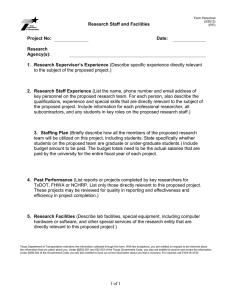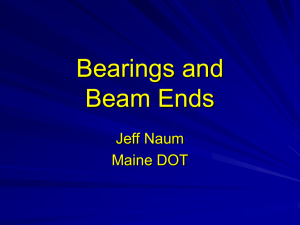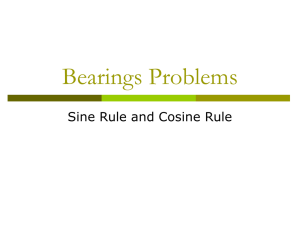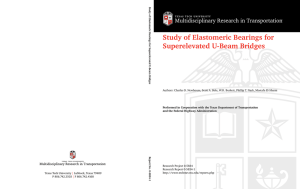Project Summary 0-5834: Study of Elastomeric Bearings for Superelevated U-Beam Bridges Background
advertisement
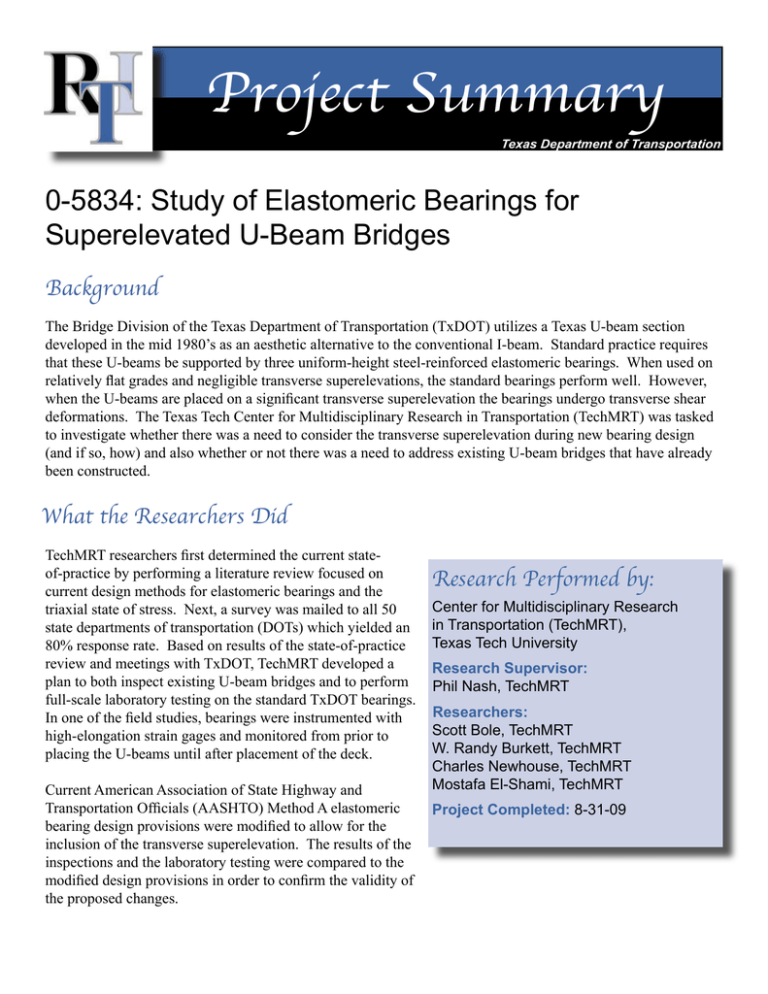
Project Summary Texas Department of Transportation 0-5834: Study of Elastomeric Bearings for Superelevated U-Beam Bridges Background The Bridge Division of the Texas Department of Transportation (TxDOT) utilizes a Texas U-beam section developed in the mid 1980’s as an aesthetic alternative to the conventional I-beam. Standard practice requires that these U-beams be supported by three uniform-height steel-reinforced elastomeric bearings. When used on relatively flat grades and negligible transverse superelevations, the standard bearings perform well. However, when the U-beams are placed on a significant transverse superelevation the bearings undergo transverse shear deformations. The Texas Tech Center for Multidisciplinary Research in Transportation (TechMRT) was tasked to investigate whether there was a need to consider the transverse superelevation during new bearing design (and if so, how) and also whether or not there was a need to address existing U-beam bridges that have already been constructed. What the Researchers Did TechMRT researchers first determined the current stateof-practice by performing a literature review focused on current design methods for elastomeric bearings and the triaxial state of stress. Next, a survey was mailed to all 50 state departments of transportation (DOTs) which yielded an 80% response rate. Based on results of the state-of-practice review and meetings with TxDOT, TechMRT developed a plan to both inspect existing U-beam bridges and to perform full-scale laboratory testing on the standard TxDOT bearings. In one of the field studies, bearings were instrumented with high-elongation strain gages and monitored from prior to placing the U-beams until after placement of the deck. Current American Association of State Highway and Transportation Officials (AASHTO) Method A elastomeric bearing design provisions were modified to allow for the inclusion of the transverse superelevation. The results of the inspections and the laboratory testing were compared to the modified design provisions in order to confirm the validity of the proposed changes. Research Performed by: Center for Multidisciplinary Research in Transportation (TechMRT), Texas Tech University Research Supervisor: Phil Nash, TechMRT Researchers: Scott Bole, TechMRT W. Randy Burkett, TechMRT Charles Newhouse, TechMRT Mostafa El-Shami, TechMRT Project Completed: 8-31-09 What They Found The state-of-practice review revealed that there has not been much research on the specific issue of triaxial loading of elastomeric bearings. Some designers contend that an elastomeric bearing should never be allowed to permanently resist a transverse load such as the load caused by placing a U-beam on a transverse slope. The survey confirmed that the state DOTs are nearly evenly split on this issue with 50% responding that they allow for members to be placed on a transverse slope and 47.5% responding that they do not allow for members to be placed on a transverse slope. The proposed modifications to the AASHTO Method A design provisions showed that including the transverse slope in new bearing design does significantly impact the design of new bearings. The proposed modifications were compared to observations in the field and to the full-scale laboratory testing. Overall, the proposed modifications matched the observations well. Electronic monitoring of existing bearings was found to be unreliable primarily because of the bulging that occurs on the sides of a steel-reinforced bearing. Instead of electronically monitoring existing bearings, TechMRT devised a way to record the condition of the bearing during the routine bridge inspection. What This Means The transverse slope should be considered in new design. Proposed revisions to the AASHTO Method A design have been suggested. Unless special provisions are made and the design calculations show that it is acceptable, U-beams should not be placed on a transverse slope exceeding 4%. For existing U-beam bridges, TechMRT recommends that the condition of the existing bearings be monitored as part of the routine bridge inspection. Recommended changes to the TxDOT “Elements” Field Inspection and Coding Manual should aid in the monitoring of the existing bearings. For More Information: Research Engineer - Wade Odell, TxDOT, 512-465-7403 Project Director - John Holt, TxDOT, 512-416-2212 Research Supervisor - Phil Nash, TechMRT, 806-742-2783 x231 Technical reports when published are available at: http://library.ctr.utexas.edu/index.html www.txdot.gov keyword: research Research and Technology Implementation Office P.O. Box 5080 Austin, Texas 78763-5080 512-465-7403 This research was performed in cooperation with the Texas Department of Transportation and the Federal Highway Administration. The contents of this report reflect the views of the authors, who are responsible for the facts and accuracy of the data presented herein. The contents do not necessarily reflect the official view or policies of the FHWA or TxDOT. This report does not constitute a standard, specification, or regulation, nor is it intended for construction, bidding, or permit purposes. Trade names were used solely for information and not for product endorsement.

